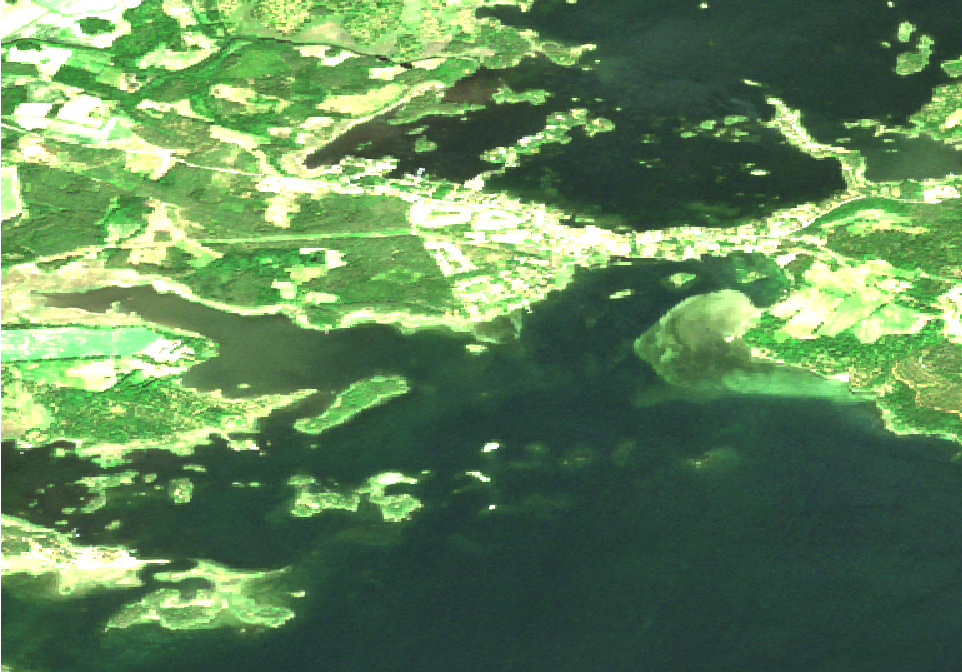SwedCoast-BlueCarb
Mapping Eelgrass Meadows in Swedish Coastal Areas - Earth Observation in support of Blue Carbon Research
OVERVIEW
The term Blue Carbon is used to represent carbon captured by the world’s ocean and coastal ecosystems. Historically, the study of Blue Carbon has focused on the long-term storage of organic carbon produced by coastal vegetation such as tidal marshes, mangroves, and seagrasses. Although their global area is one to two orders of magnitude smaller than that of terrestrial forests, the relative contribution of coastal vegetation to long-term carbon sequestration is much greater. These tidal and underwater vegetation systems are key to the Carbon Dioxide (CO2) budget and our planet’s climate. In addition to capturing CO2 via photosynthesis, these systems trap suspended matter and associated organic carbon imported from the catchment and during tidal inundation and provide shallow habitats where micro and filamentous algae can flourish.
An example of a Blue Carbon habitat is eelgrass meadows (Zostera marina) along the Swedish West Coast and sago pondweed (Potamogeton pectinatus) in the Baltic Sea, which provide habitats and spawning grounds for fish and are crucial for healthy and self-sustaining fisheries. Therefore, it is essential to map Blue Carbon habitats to ensure proper management and inclusion in net zero emission calculations. However, this mapping has proven difficult in shallow marine and brackish habitats, as the absorption of light by the water can prevent satellites from precisely seeing what is happening at depth. Also, carbon storage is primarily related to the roots rather than leaves for coastal vegetation.
The project evaluates and executes such mapping by combining satellites, field data, and specialist knowledge. In addition to contributing information on Baltic blue carbon and climate change, results provide data on the effect of land type and land use on coastal water quality. Project outputs include peer-reviewed publications and an online decision support tool providing an easy-to-access resource for coastal managers. A paper on the effect of land use on water quality was published as the project's first deliverable (Kratzer and Allart, 2023).
Application site(s)
Sweden
- Swedish West Coast:
- Territory 1: Kristineberg bay, Gullmaren, Skagerrak.
- Territory 2: Lomma bay, Öresund.
- Baltic Sea coastal areas:
- Territory 3: Southern Kalmar straight, Baltic proper.
Data
Satellite
The key data for mapping underwater eelgrass and/or macroalgal vegetation will be Copernicus Sentinel-2 and Sentinel-3 missions supplemented by hyperspectral data from satellite missions such as EnMAP and PRISMA and commercial datasets from missions such as WorldView.
Sentinel-2 will be the primary source as it can provide a baseline dataset at 10 m spatial resolution with a regular repeat frequency. Sentinel-3 has a much coarser spatial resolution but is designed to measure water quality, so it will support the accurate determination of water quality and optical properties that impact the extraction of information about the submerged vegetation.
Other
National monitoring data on underwater vegetation will be provided by the Västerbotten County Administrative Board (LST Västerbotten), including drop monitoring video and drone data for several coastal sites in the Baltic Sea. We will also collaborate with macroalgal specialists from the Swedish West Coast.
Additionally, we will use existing optical water quality data from the Department of Ecology, Environment and Plant Biology (DEEP), Stockholm University, for algorithm development.
Results - Final product(s)
The aim is to produce maps of underwater vegetation (e.g., eelgrass, pondweed, and macroalgae alongside bottom substrates), with the associated uncertainties, for the investigation sites. These datasets will be hosted in an open-access online decision support toolproviding a dashboard/map setup, allowing stakeholders and the broader public to interrogate the data and generate summary information for underwater eelgrass meadows.
References
Kratzer, S. et Allart, M., 2023. Links between Land Cover and In-Water Optical Properties in Four Optically Contrasting Swedish Bays. Remote Sensing, 16(1), p.176.
Consortium and financing
The Swedish participation in the project is funded by the Swedish National Space Agency (SNSA; Dnr. 2024-00004), while the participation of Pixalytics is funded by the UK Space Agency (UKSAG24_004). The team will jointly develop the satellite algorithms, and Pixalytics will set up the portal for data access. The project is also co-funded by the SNSA project 'The use of Copernicus Sentinel-3 data for research and societal needs', Dnr. 2021-00064, PI: S. Kratzer.
Project news
🎥 04/07/2025: Presentation of the SwedCoast-BlueCarb project and its progress at the 1st ClimateSCOpe “Monitoring our oceans”





